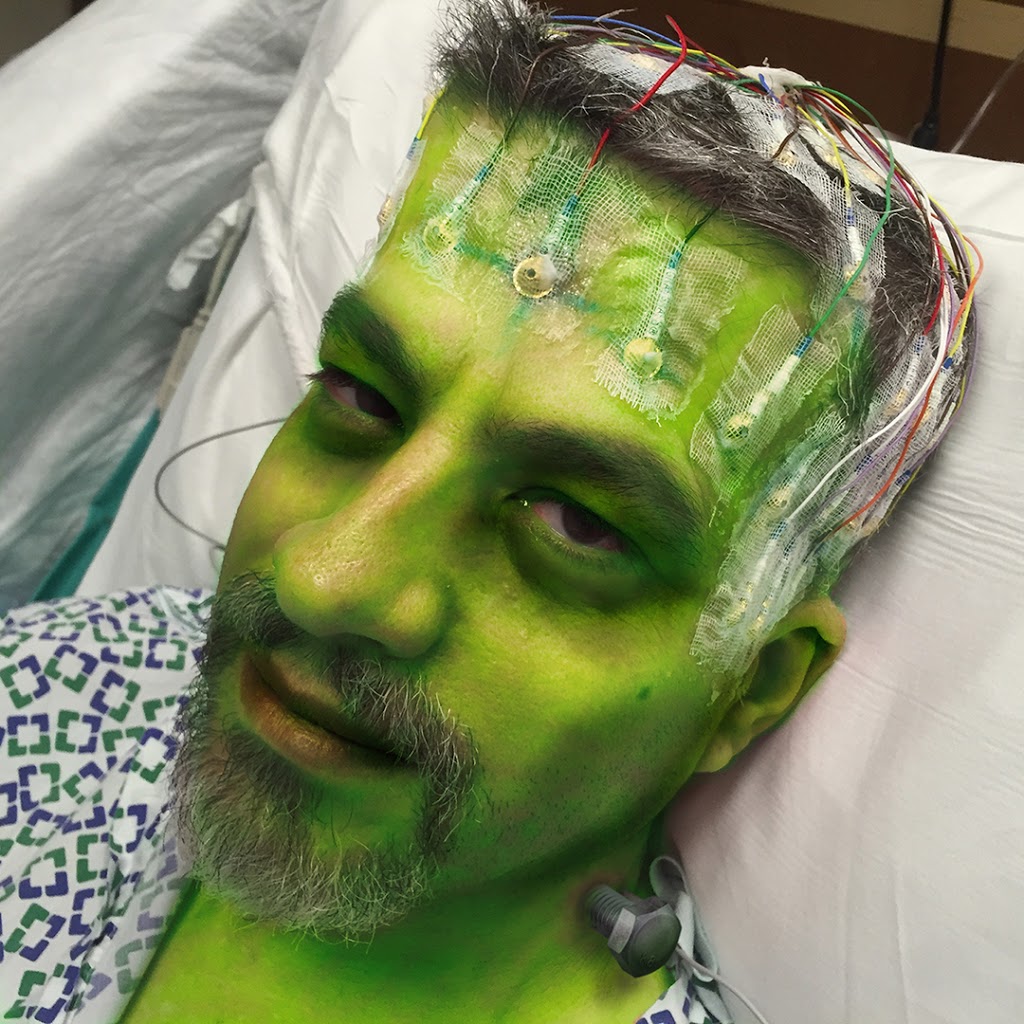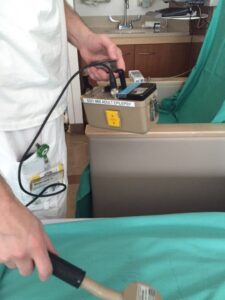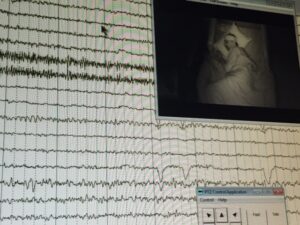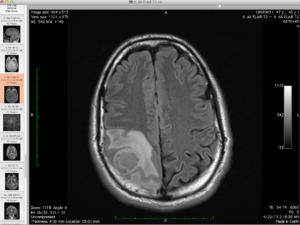Days Two-Four at Cleveland Clinic: Radiate and Sedate

When I saw this photo of my husband so cleverly manipulated by his dear friend and fellow artist, Anthony Mestas, I laughed my rear right off (only figuratively unfortunately). It is a perfect visual representation of how Dan felt on days two through four at the Clinic while at the same time turning my husband into his favorite classic horror monster. Being able to laugh through this utter poop pile and having friends that refuse to allow you to do anything but, is absolutely priceless. If you could have been with us in room nine of the adult epilepsy monitoring unit, you would have full appreciation of that which I speak. It sucked. Bad.
On days two and three, Dan was taken off all his epilepsy meds. Not only did his seizure activity increase but Dan found himself in the wicked throes of withdrawal which included “the walls throbbing”, “trails”, “hearing voices”, stomach upset, headaches, body aches and on and on. I know this might also sound like the beginning of a stellar magical mushroom trip to some of you but be assured, that was not the case. Think more on the lines of certain scenes from Trainspotting and you’d be more accurate.

In the middle of this, one of the nurses sat next to Dan for hours on end waiting to inject radioactive tracer, or Neurilite, at the first sign of an intense seizure.
This Neurilite shoots through the body and to the brain, tracing an increase in cerebral blood flow which usually represents the site in the brain that the seizures are starting. They inject the radioactive juice one more time when things are relatively normal to get a baseline. By looking at this Ictal SPECTAnalysis, as well as a million other little things, epileptologist can hopefully pin point the specific area of the brain that the seizures are starting and then surgically remove this site if safe to do so.

Wednesday proved to be even worse, as Dan’s typical seizure activity turned into a full-blown nine-minute tonic clonic (grand mal) that sent everyone into a panic, including the nurses. The goal here is to allow the patient to have smaller seizures so they can be traced in the brain.
Once a big seizure hits, the brain waves become so huge and chaotic that the monitor goes completely black and no data can be recorded. Not only was Dan’s monitor black, but a whole team of nurses swarmed the room, injecting meds to try and stop the seizure, placing an oxygen mask on my husband’s writhing frame, suctioning out his foaming mouth as his body went through the same physical exertion of running a full 26 mile marathon in nine minutes.
Though this experience was traumatic for everyone there to witness it (including some of the nurses), the doctors finally got what they needed. The first few minutes of the seizure had been localized, meaning that only his arm was involved. This allowed them to collect the necessary data to help pinpoint the origin of Dan’s seizures. Mission accomplished. Dan is fed a super dose of Lamictal ground up in applesauce before he is even fully aware of who he is or where he’s at. Next comes the Keppra and Clanazepam. Then finally, sleep.
On Thursday, the whole team of doctors, including some of the best epileptologist and neurosurgeons in the world, met to look over the data and come to some conclusion. On Friday, Dr. Najm gave us their final analysis and recommendation. They think that Dan is dealing with two different issues. To begin, he obviously has epilepsy. But the seizure activity that he has daily (burning, tingling, numbness, cramping) is not seizure activity at all. They think that it is phantom pains caused by the ganglia being sliced during his first brain surgery. This cannot be fixed. Secondly, his true seizures appear to be starting at the top of the brain near the surgical site.
There is the possibility that scar tissue and a pocket of blood due to his craniotomy is pressing down on his brain causing it to seize. Though it is surgically possible to try and clean this mess up and remove the pressure, it is also dangerous.

It could make Dan’s phantom pains worse. It could make his seizures worse. It could cause him to lose the ability to move the left side of his body. There is so little left of the top portion of his parietal lobe, that any manipulation of the area could have dire consequences. Surgery is not recommended.
So what do we do now? Dr. Najm, whom we grew to adore over the week, gave us some simple advice. GO HAVE FUN. Kinda sucks and is not exactly what we expected. There was a change in meds to help alleviate Dan’s phantom pains and just knowing that these phantom pains are not going to lead into a grand mal has alleviated a tremendous amount of anxiety. But I would be a liar if I did not admit to having dreams of the old Dan. The Dan who could run. The Dan who could drive. The Dan who never passed up a mosh pit. But for all the things he can’t do, there are a million more that he can and we will focus on those. We will focus on our brilliant teenage kids, our families and our friends, and this present moment, which is too sublimely beautiful to let go without celebration. LET’S GO HAVE FUN!


